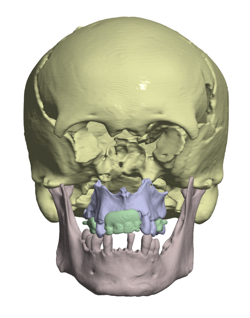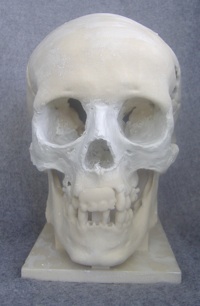
Identity of Canadian WWI soldier discovered using 3D printing
By Design Engineering Staff
CAD/CAM/CAE 3D printing calgary rapid prototyping University of Western Ontario ZcorpResearchers use 3D scanning and rapid prototyping techniques to reconstruct remains.
Burlington, Mass. – An unknown soldier, killed in action in the First World War, has been identified using a combination of disciplines, including Z Corporation 3D printing technology.
The remains of the solider, now identified as 28-year-old Private Thomas Lawless of Calgary, Alberta, were discovered in 2003 at a construction site near Avion, France. He was killed in action on June 8, 1917, a few months after the Battle of Vimy Ridge. His remains were buried in France last week.
To make the identification, researchers employed a combination of historical research, forensic anthropology (the study of the human skeleton), facial reconstruction and isotopic analysis.
“Although it’s sad to contemplate the loss of young lives in war, it’s rewarding to account for the missing, both for the sake of the deceased and for long-grieving family members,” said Andrew J. Nelson, a key researcher on the project and Associate Dean of Research for the Faculty of Social Science at the University of Western Ontario.
The identification team created 3D computer models of Lawless’s skull, derived from CT scan data of several large skull fragments, in order to narrow the list of possible matches for the remains. Physical models of the skull were produced using a 3D printer.
Using muscle markings on the skull model, scientific tissue-depth tables and plastilina modeling clay, the team worked with artist Christian Corbet to construct a face on the model. They then photographed that face, and superimposed images of it on photographs of soldiers who were potential matches.
By seeing how the images lined up – by face height, width and features such as jaw shape – the team was able to narrow the list of potential matches to two. An isotopic analysis of teeth and the jawbone indicated that the recovered soldier grew up in Dublin – a direct biographical match with Lawless.
“Anthropological analysis and mitochondrial DNA testing are standard approaches for identification,” Nelson explained. “However, mtDNA requires material from living family members on the maternal side to make a connection. In this case, we had none of that at our disposal. To the best of my knowledge, this is the first instance in which facial reconstruction and isotopic analysis were added to the mix. It may result in a new protocol, or certainly new tools, for the identification of the missing.”
Private Thomas Lawless, born April 11, 1889, was a member of the 49th Battalion, Canadian Expeditionary Force and was buried March 15, 2011, at La Chaudiere Military Cemetery in Vimy, France, with his family in attendance. La Chaudiere, a Commonwealth War Graves Commission cemetery, currently has 907 servicemen from the First World War buried or commemorated there, including Private Herbert Peterson, the soldier found in 2003 with Private Lawless.
Nelson sees a variety of applications for 3D printing in anthropology beyond the identification of soldiers’ remains. For example, his team used 3D printing in the 2003 facial reconstruction of an Egyptian mummy housed at the Chatham-Kent Museum in Chatham, Ontario. But that’s just scratching the surface, he says.
“Societies who wish to move forward must know their past to better understand who they are now and where they might be going,” he said. “The high variability of cultures of the past – before the internetworking of the world – tells us a lot about the interplay of traits like gender, status, health and wealth in different settings.
It’s the bones that help us associate those cultural traits with a particular set of human remains,” he added. “And though CT scans enable us to a look inside a mummy, for example, without disturbing the bones, wrappings and so on, 3D printing lets us extract these pieces, figuratively speaking, by creating a physical model from CT scan data. We can thus examine the bones more closely and learn more from them.”
www.zcorp.com


